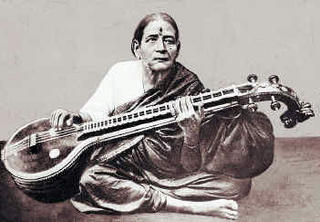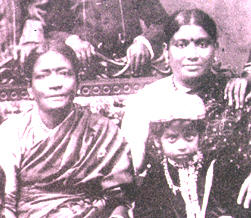Dhanam – the riches of Veena
Dr. K. Rohiniprasad

 Veena Dhanammal (left) with her daughter T. Lakshmiratnam
Veena Dhanammal (left) with her daughter T. Lakshmiratnamand grandson T. Vijayakrishnan
Dhanammal (1868 -1938), the great veena-player belonged to a lineage of musicians and dancers at the Tanjavur court. Her grandmother Kamakshiamma was a well-known vocalist and dancer while her mother Sundaramma was trained by Subbaraya Sastry, son of Shyama Sastry. A precocious child, Dhanammal had a fine, sweet voice that blended with the veena. Dhanam learnt music from her mother as well as Sathanur Panchanada Ayyar, Alasingarayya, Balakrishnayya, Dharmapuri Subbaraya Ayyar, Baldas Naidu and Saidapet Tirumalachariar. Though veena was considered a family heirloom, it was felt it had some inadequacies. However young Dhanam was inspired and enlightened by two distinguished veena artists, Ramachandra and Kalyanakrishna. The youngster noticed endless possibilities on the veena for higher musical expression. Neelakantha Sastri, another great contemporary of Dhanam, helped to train her.
With the veena as the only interest in her life, Dhanam’s boundless energy and dynamism brought her fame even while in her teens. Her repertoire of more than a thousand songs by seventy composers in six languages outlined her musical perspective and aesthetic sensitivity.
Dharmapuri Subbarayar, a composer of javalis became a great fan and patron of Dhanam and placed at her disposal his wealth and powerful influence. Similarly, the blind musician Baladas Naidu of Wallajahpet, an expert on Kshetrayya’s padams and Saidapet Tirumalachariar helped Dhanam fashion new patterns as it were, on old fabric.
Dhanam’s concert in
Dhanammal’s raga alapana was brief but very suggestive, its various facets shining with glorious lustre. She would render complex ragas like Athana, Surati, Begada, Darbar and Khamaj, alternating her playing with her singing. With clear grasp of the raga system she could expound the beauty and grandeur of every raga on the veena. Her sublime tanam rendered in a deliberate, well-ordered plan and perfect resonance showcased her genius and supreme mastery over the instrument. Perfect in thought, word and deed, she developed an individual veena-playing style of her own, with delicate gamakas and emphasis on the mood of the raga. She avoided tanpura and mridangam accompaniment, believing veena to be a complete instrument.
With prolific creative faculty, Dhanammal often sang while playing on the veena. Her voice was sweet, clear and powerful and remained uniform over three octaves, merging admirably with the veena. Her pronunciation in six languages was flawless and she rendered them with feeling.
Great musicians and music lovers frequented her house for her Friday concerts. Raja Nawab Ali Khan Chowdary, a participant in the Simon Commission and the Raja of Tehri heard her performances in
Dhanammal’s brother Narayanaswami was a famous violinist. She taught music to her four daughters and her grandchildren Balasaraswathi (bharatanatyam), Brinda and Mukta (vocal), T Viswanathan (flute) and T. Ranganathan (mridangam) rose to fame. Her style is perhaps considered too pure and profound to satisfy today’s preference for speed and fireworks.
Towards the end of her life Dhanammal’s eyesight failed. There were some recordings, but due to some dispute, the originals were later destroyed by the recording company.

3 Comments:
please anyone is having late.shri subbaraya sastry's photo please
Hi,, i wud like to make a note of an amazing veena artist at Mangalore, India, She plays Veena in Gamaka style.. she's awsome as i felt, more over its surprising that she's Blind.. check out
www.aruna-veena.blogspot.com
In your article you mention that Veena Dhanammal was inspired by Kalyanakrishna Bhagavatar (KB). Yes that might be true because he was legendary during his time. I am intetested in the source of this information and more details.
Post a Comment
<< Home